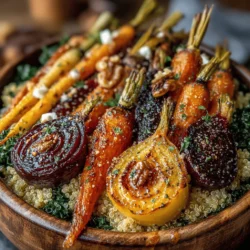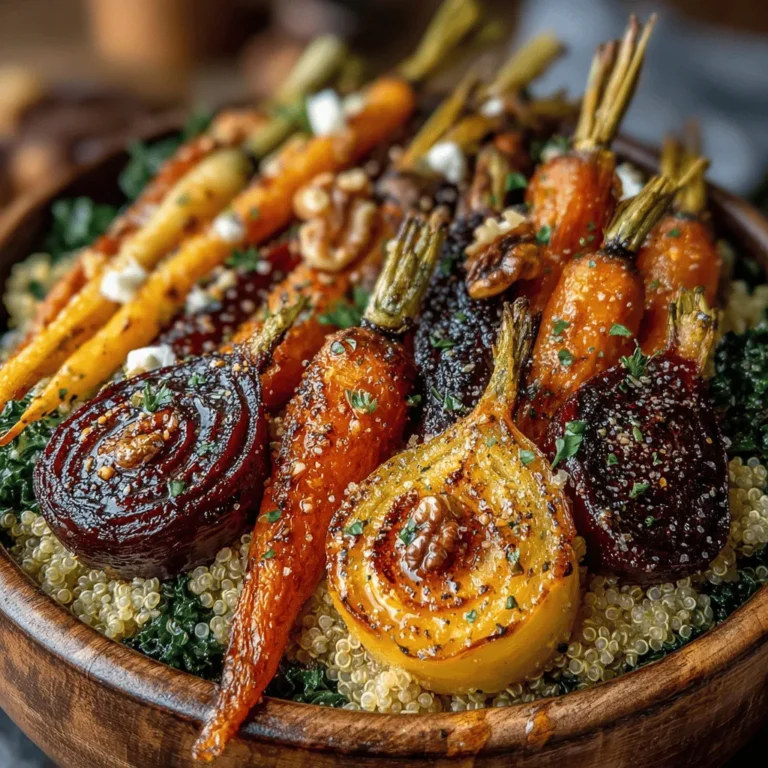Maple Roasted Root Veggie & Quinoa Bowl: A Wholesome Delight
The Maple Roasted Root Veggie & Quinoa Bowl is a celebration of seasonal flavors, combining the earthy sweetness of roasted root vegetables with the nutty texture of quinoa. This dish not only serves as a nutritious meal but also warms the soul, making it a perfect choice for colder months. Packed with vitamins, minerals, and wholesome ingredients, this bowl is a powerhouse of nutrition, appealing to those seeking a healthy, satisfying meal. With its vegan and gluten-free qualities, it caters to a wide array of dietary preferences, ensuring that everyone can enjoy its comforting goodness.
Root vegetables, such as carrots, sweet potatoes, parsnips, and beets, are the stars of this recipe. Harvested during the fall and winter months, these veggies are at their peak in flavor and nutrition, providing hearty sustenance as the weather turns chilly. The addition of maple syrup not only enhances their natural sweetness but also infuses the dish with a rich, complex flavor that perfectly complements the earthy tones of the vegetables.
Understanding the Ingredients
To create a truly delightful Maple Roasted Root Veggie & Quinoa Bowl, it’s essential to understand the role and benefits of each ingredient.
Quinoa: Often hailed as a superfood, quinoa is a complete protein, meaning it contains all nine essential amino acids. This ancient grain is also gluten-free and rich in fiber, making it an excellent choice for those looking to maintain a healthy diet. With a light, fluffy texture when cooked, quinoa serves as the perfect base for our veggie bowl, absorbing the flavors of the roasted vegetables and maple syrup.
Root Vegetables: The combination of carrots, sweet potatoes, parsnips, and beets not only adds vibrant colors to the bowl but also a variety of nutritional benefits. Carrots are rich in beta-carotene, which supports eye health, while sweet potatoes provide a good source of vitamin A and potassium. Parsnips, with their unique sweetness, offer a high fiber content, aiding digestion. Beets are known for their detoxifying properties and are packed with essential nutrients like folate and manganese.
Kale: This leafy green is a nutritional powerhouse, loaded with vitamins A, C, and K, as well as antioxidants. In this recipe, kale adds a delightful crunch and a burst of color, while also bringing additional health benefits. Sautéed or massaged lightly, it can retain its crispness, providing a refreshing contrast to the roasted vegetables.
Maple Syrup: As a natural sweetener, maple syrup not only enhances the flavor of the dish but also comes with its own set of health benefits. Rich in antioxidants and minerals like manganese and zinc, it offers a healthier alternative to refined sugars. The depth of flavor that maple syrup adds to the root vegetables elevates this dish from ordinary to extraordinary.
Walnuts: These nutrient-dense nuts are a great source of healthy fats, protein, and omega-3 fatty acids. They add a delightful crunch to the bowl, providing texture and a satisfying mouthfeel. Additionally, walnuts are known for their anti-inflammatory properties, making them a beneficial addition to any meal.
Feta Cheese (Optional): For those who include dairy in their diet, crumbled feta cheese can be a delicious finishing touch. Its creamy texture and tangy flavor contrast beautifully with the sweetness of the roasted vegetables, enhancing the overall taste profile of the dish.
Preparation Steps and Techniques
To ensure your Maple Roasted Root Veggie & Quinoa Bowl turns out perfectly, proper preparation of the vegetables is key. Begin by selecting fresh, seasonal root vegetables. Aim for uniform sizes when cutting them to promote even roasting. For instance, slice carrots and parsnips into similar-sized sticks and cube sweet potatoes and beets into even pieces. This attention to detail will ensure that each vegetable roasts evenly, achieving that sought-after caramelization.
Next, seasoning plays a crucial role in enhancing the flavors of your dish. A balanced mix of olive oil, maple syrup, salt, and freshly cracked pepper will not only season the vegetables but also help them to roast beautifully. The olive oil serves as a healthy fat that aids in the cooking process, while the maple syrup will caramelize during roasting, adding depth and sweetness.
Incorporating herbs and spices can take your roasted vegetables to the next level. Thyme and garlic powder are excellent choices that pair wonderfully with root vegetables. Thyme adds an aromatic quality that complements the sweet notes of the maple syrup, while garlic powder infuses a savory essence that balances the sweetness.
Roasting the Vegetables
Roasting is the technique that will transform your prepared vegetables into golden, caramelized bites of goodness. Preheat your oven to 425°F (220°C), which is the optimal temperature for roasting root vegetables. This high heat encourages caramelization, resulting in a delightful contrast between crispy exteriors and tender interiors.
Once your vegetables are tossed in olive oil and maple syrup, spread them out in a single layer on a baking sheet. This prevents overcrowding, allowing the vegetables to roast rather than steam. After about 20 minutes, take the time to stir the vegetables. This halfway point is crucial as it promotes even cooking and caramelization, ensuring all sides of the veggies are beautifully roasted.
As the vegetables roast, they will develop a rich, deep flavor that pairs perfectly with the nutty quinoa, creating a dish that is not only visually appealing but also deeply satisfying.
Stay tuned for the next part, where we will delve into assembling the bowl and adding the finishing touches that make the Maple Roasted Root Veggie & Quinoa Bowl a truly irresistible meal.
{{image_2}}
Visual and Textural Transformations During Roasting
Roasting root vegetables is a transformative process that enhances their natural sweetness and depth of flavor. As these veggies—such as carrots, sweet potatoes, and beets—cook, they undergo a delightful caramelization that brings out a rich, toasty flavor profile. The high heat of roasting causes the sugars in the vegetables to brown, creating a crispy exterior while maintaining a tender interior. This contrast in texture not only makes the dish more enjoyable but also elevates the visual appeal, making the vibrant colors of the veggies pop against the backdrop of the earthy quinoa.
The key to achieving the perfect roast is using a hot oven (around 400°F to 425°F). The combination of high temperatures and a little bit of oil allows the vegetables to develop a golden crust while preventing them from steaming. This method ensures that each bite delivers a satisfying crunch paired with the soft, sweet flesh of the vegetables, making your Maple Roasted Root Veggie & Quinoa Bowl a feast for both the eyes and the palate.
Cooking Quinoa to Perfection
Step-by-Step Guide on Cooking Quinoa
Cooking quinoa is a straightforward process, but following these steps ensures that you achieve the best results:
1. Rinse the Quinoa: Begin by measuring out your quinoa. Use a fine-mesh strainer to rinse it under cold running water for about 1-2 minutes. This step is crucial, as quinoa has a natural coating called saponin, which can impart a bitter taste if not removed.
2. Cook the Quinoa: In a medium saucepan, combine 1 cup of rinsed quinoa with 2 cups of water or vegetable broth for added flavor. Bring the mixture to a boil over medium-high heat.
3. Simmer: Once boiling, reduce the heat to low, cover the saucepan, and let it simmer for about 15 minutes. Avoid lifting the lid during this time, as it will release steam and affect the cooking process.
4. Fluff: After 15 minutes, remove the saucepan from heat and let it sit, covered, for an additional 5 minutes. This resting period allows the quinoa to absorb any remaining liquid. Finally, use a fork to fluff the quinoa gently.
Importance of Rinsing Quinoa and the Impact on Flavor
Rinsing quinoa is essential not only for removing the bitter taste caused by saponins but also for improving the overall flavor of the dish. Unrinsed quinoa can have a soapy or grassy flavor that detracts from its natural nuttiness. By rinsing, you ensure that the final dish features the rich, earthy taste quinoa is known for, making it a perfect complement to the sweetness of the maple-roasted vegetables.
Tips for Achieving Fluffy Quinoa and Avoiding Mushiness
To achieve perfectly fluffy quinoa, consider these tips:
– Water Ratio: Stick to the 2:1 water-to-quinoa ratio for optimal texture. Too much water will lead to mushy quinoa, while too little will leave it undercooked.
– Resting Time: Allowing the quinoa to rest off the heat covered for a few minutes is critical for achieving a fluffy consistency. This step lets the grains finish cooking in their steam.
– Fork Fluffing: Use a fork instead of a spoon to fluff the quinoa gently. This technique helps separate the grains without crushing them, preserving their individual texture.
Sautéing Kale for Added Nutrition
Benefits of Sautéing Over Other Cooking Methods
Sautéing kale is an excellent way to prepare this nutrient-dense green while preserving its vibrant color and essential nutrients. Unlike boiling, which can leach vitamins and minerals into the water, sautéing quickly cooks the kale, allowing it to retain its nutritional profile. The high heat and quick cooking time enhance the flavor and make the kale tender without losing its bright green hue.
Retaining Nutrients While Enhancing Flavor
When sautéing kale, you can enhance its flavor profile by using a bit of oil, garlic, or onion. These additions not only make the dish more flavorful but also contribute to the overall health benefits, as garlic has its own medicinal properties. For optimal nutrient retention, sauté the kale over medium heat for about 5-7 minutes until it wilts but remains bright green and slightly crunchy.
Suggested Cooking Time and Temperature for Perfect Wilted Kale
For perfectly sautéed kale, heat a tablespoon of olive oil in a large skillet over medium heat. Add minced garlic (if desired) and sauté for about 30 seconds until fragrant. Then, add the kale, tossing it occasionally. Cook for approximately 5-7 minutes until the leaves are wilted but still vibrant. Season with salt and pepper to taste before removing from heat.
Assembling the Maple Roasted Root Veggie & Quinoa Bowl
Layering Technique for an Appealing Presentation
The way you assemble your Maple Roasted Root Veggie & Quinoa Bowl can elevate the dining experience. Start with a base of fluffy quinoa, then layer on the roasted root vegetables. This not only looks appealing but also allows for the flavors to meld beautifully.
1. Base Layer: Place a generous scoop of quinoa in the bottom of your bowl.
2. Vegetable Layer: Add a colorful array of roasted root vegetables on top. The contrast of colors—orange from carrots, deep purple from beets, and golden-yellow from sweet potatoes—creates an inviting visual spectacle.
3. Kale Layer: Finally, top the bowl with sautéed kale for a pop of green.
Visual Appeal of Colorful Layers
The visual appeal of the dish lies in its colorful layers. The mix of vibrant vegetables not only makes it Instagram-worthy but also ensures that you are consuming a variety of nutrients. Each color represents different vitamins and minerals, making this bowl a nutritional powerhouse.
Suggestions for Garnishes, Such as Fresh Herbs
To enhance the presentation and flavor, consider garnishing your bowl with fresh herbs like parsley, cilantro, or chives. A sprinkle of toasted seeds or nuts can also add a delightful crunch and additional health benefits.
Optional Additions and Variations
Feel free to customize your Maple Roasted Root Veggie & Quinoa Bowl based on seasonal produce or personal preferences. Here are some optional additions:
– Protein Boost: Add grilled chicken, chickpeas, or tofu for an extra protein punch.
– Cheese: Crumbled feta or goat cheese can add richness and flavor.
– Dressings: Drizzle with a balsamic reduction or a tahini dressing for added creaminess.
Other Toppings and Ingredient Substitutions
This bowl is incredibly flexible, so don’t hesitate to experiment with different toppings and ingredient substitutions. For instance, swap quinoa for farro or brown rice for a different texture. You can also use different vegetables based on what you have on hand—think Brussels sprouts, zucchini, or bell peppers.
Nutritional Value and Health Benefits
Breakdown of Calories and Nutrients Per Serving
Each serving of the Maple Roasted Root Veggie & Quinoa Bowl is around 400-500 calories, depending on the specific ingredients used. This dish is rich in fiber, vitamins, and minerals, providing a well-rounded meal that supports overall health.
– Quinoa: A complete protein source, quinoa provides all nine essential amino acids, making it an excellent choice for vegetarians and vegans.
– Root Vegetables: Carrots, sweet potatoes, and beets are high in antioxidants, vitamins A and C, and offer significant anti-inflammatory benefits.
– Kale: Packed with vitamins K, A, and C, kale is a superfood that supports bone health and boosts the immune system.
Health Benefits of Incorporating a Variety of Vegetables and Whole Grains
Incorporating a mix of colorful fruits and vegetables into your diet enhances your nutritional intake. Each color represents different nutrients that are vital for maintaining good health. Whole grains like quinoa provide sustained energy and help you feel fuller for longer, making this dish a satisfying option that can support weight management.
Discussion on the Dietary Flexibility of the Dish
The Maple Roasted Root Veggie & Quinoa Bowl is not only delicious; it’s also incredibly versatile. It fits well within various dietary preferences, including vegetarian, vegan, gluten-free, and even paleo (with some adjustments). This flexibility makes it a go-to recipe for meal prepping, family dinners, or casual lunches.
Conclusion
In conclusion, the Maple Roasted Root Veggie & Quinoa Bowl is a delightful combination of flavors, textures, and nutritional benefits that make it a must-try recipe. The roasted root vegetables paired with fluffy quinoa and nutrient-rich sautéed kale create a wholesome dish perfect for any meal of the day.
We encourage you to experiment with your variations and seasonal produce, making this bowl your own. Whether you’re looking for a nourishing lunch or a hearty dinner, this recipe is sure to satisfy your cravings while providing a wealth of health benefits. Enjoy the beauty of vibrant colors and flavors in one bowl, and embrace the joy of cooking with fresh, wholesome ingredients.


